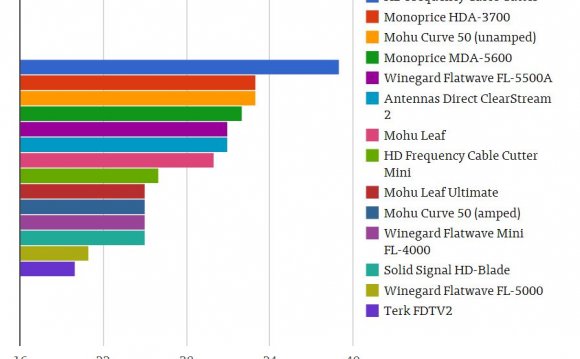
If you live in an area where signals are relatively strong, there's a bevy of effective antennas that earn praise from experts and users. Though results vary based on how far you are from the broadcast towers, what channels your local broadcasters use, topography, intervening obstacles such as trees and buildings, and phases of the moon (we are kidding about the last one, though judging by the reviews we see, maybe not so much), we are naming the Mohu Leaf 30 (Est. $35) as the Best Reviewed HDTV antenna for most individuals. This is the middle model in Mohu's series of flat antennas. Other options include the Mohu Leaf 50 (Est. $60), which includes a low-noise amplifier to boost the Leaf's range from 30 miles to 50 miles, at least theoretically, and the Mohu Leaf Metro (Est. $20), a half-sized version designed for use in metro areas with strong signal levels.
Regardless of the model, the Mohu Leaf has its strongest performance on the UHF bands, where most HDTV signals can be found. It's also a decent performer with high-band VHF channels (7-13). Performance with low-band VHF (channels 2-6) is pretty spotty, but that's true of many HDTV antennas and relatively few locations have broadcasters that use those channels.
If aesthetics are a concern, the Leaf rates a thumbs-up in reviews. It places the antenna's receiving elements within a thin plastic laminate. Installation is simple as it can just be tacked up on a wall (pushpins are included). One side is black and the other white, and it's paintable if neither of those options work with your décor. The super-thin design is also easy to hide. While the company suggests placing the antenna behind a picture, several reviewers say they placed the Leaf behind their sets.
In terms of performance, the all three versions of the Leaf hold their own and even beat some more expensive options in comparative tests. All have been put through their paces by Peter Putman at HDTVExpert.com, and all earn good feedback there. The Leaf 50, with its amplifier, does a little better job pulling in challenging stations in tests, but could also be overkill for some users. Tom's Guide's Mike Kobrin notes that the Mohu Jolt Amplifier (Est. $30) that's included with the Leaf 50 is also sold separately. "You could also start with the Leaf 30 and buy the Jolt later for $30 if you need the boost, " he suggests.
Though it's only a good match for areas where signals are the strongest, Tom's Guide names the Metro as the Editor's Choice among non-amplified HDTV antennas. Putnam is a fan as well: "I'd recommend this one for city dwellers, and you shouldn't need any additional amplification, " he says. User reviews are also relatively positive for an indoor HDTV antenna - 3.8 stars for the three versions combined after more than 10, 000 user reviews at Amazon.com - but they also indicate that the Leaf isn't a miracle worker. If other indoor-antenna designs won't work at your location, the odds are slim that the Leaf will do significantly better.
With the success of the Leaf, it's not surprising that other manufacturers have released similar antennas. One example is the Winegard FlatWave series. It's available in versions that correspond to the offerings in the Leaf line, including the amplified Winegard FlatWave Amped (Est. $60), the unamplified Winegard FlatWave (Est. $35) and the urban-dweller oriented, Wineguard FlatWave Micro (Est. $22). Some reviews reference a semi-clear frosted plastic aesthetic, but the current version mimics (again) the Leaf's reversible black/white design. While Tom's Guide finds that the FlatWave Amped performs a little bit better than the Leaf 50 in its test locations, Putnam at HDTVExpert.com calls it a coin flip. "Use either of these if you are 15 – 30 miles out from the TV transmitters and have a reasonably clear reception path, " he says.








